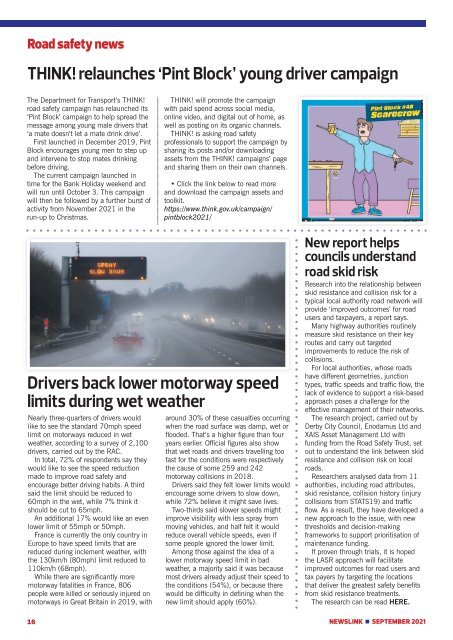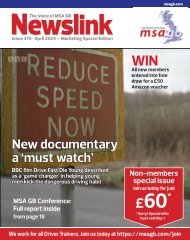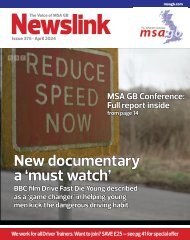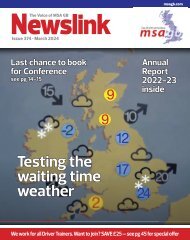Newslink September 2021
Motor Schools Association of Great Britain membership magazine; driving instructors, road safety, motoring news
Motor Schools Association of Great Britain membership magazine; driving instructors, road safety, motoring news
- No tags were found...
Create successful ePaper yourself
Turn your PDF publications into a flip-book with our unique Google optimized e-Paper software.
Road safety news<br />
THINK! relaunches ‘Pint Block’ young driver campaign<br />
The Department for Transport’s THINK!<br />
road safety campaign has relaunched its<br />
‘Pint Block’ campaign to help spread the<br />
message among young male drivers that<br />
‘a mate doesn’t let a mate drink drive’.<br />
First launched in December 2019, Pint<br />
Block encourages young men to step up<br />
and intervene to stop mates drinking<br />
before driving.<br />
The current campaign launched in<br />
time for the Bank Holiday weekend and<br />
will run until October 3. This campaign<br />
will then be followed by a further burst of<br />
activity from November <strong>2021</strong> in the<br />
run-up to Christmas.<br />
THINK! will promote the campaign<br />
with paid spend across social media,<br />
online video, and digital out of home, as<br />
well as posting on its organic channels.<br />
THINK! is asking road safety<br />
professionals to support the campaign by<br />
sharing its posts and/or downloading<br />
assets from the THINK! campaigns’ page<br />
and sharing them on their own channels.<br />
• Click the link below to read more<br />
and download the campaign assets and<br />
toolkit.<br />
https://www.think.gov.uk/campaign/<br />
pintblock<strong>2021</strong>/<br />
Drivers back lower motorway speed<br />
limits during wet weather<br />
Nearly three-quarters of drivers would<br />
like to see the standard 70mph speed<br />
limit on motorways reduced in wet<br />
weather, according to a survey of 2,100<br />
drivers, carried out by the RAC.<br />
In total, 72% of respondents say they<br />
would like to see the speed reduction<br />
made to improve road safety and<br />
encourage better driving habits. A third<br />
said the limit should be reduced to<br />
60mph in the wet, while 7% think it<br />
should be cut to 65mph.<br />
An additional 17% would like an even<br />
lower limit of 55mph or 50mph.<br />
France is currently the only country in<br />
Europe to have speed limits that are<br />
reduced during inclement weather, with<br />
the 130km/h (80mph) limit reduced to<br />
110km/h (68mph).<br />
While there are significantly more<br />
motorway fatalities in France, 806<br />
people were killed or seriously injured on<br />
motorways in Great Britain in 2019, with<br />
16<br />
around 30% of these casualties occurring<br />
when the road surface was damp, wet or<br />
flooded. That’s a higher figure than four<br />
years earlier. Official figures also show<br />
that wet roads and drivers travelling too<br />
fast for the conditions were respectively<br />
the cause of some 259 and 242<br />
motorway collisions in 2018.<br />
Drivers said they felt lower limits would<br />
encourage some drivers to slow down,<br />
while 72% believe it might save lives.<br />
Two-thirds said slower speeds might<br />
improve visibility with less spray from<br />
moving vehicles, and half felt it would<br />
reduce overall vehicle speeds, even if<br />
some people ignored the lower limit.<br />
Among those against the idea of a<br />
lower motorway speed limit in bad<br />
weather, a majority said it was because<br />
most drivers already adjust their speed to<br />
the conditions (54%), or because there<br />
would be difficulty in defining when the<br />
new limit should apply (60%).<br />
New report helps<br />
councils understand<br />
road skid risk<br />
Research into the relationship between<br />
skid resistance and collision risk for a<br />
typical local authority road network will<br />
provide ‘improved outcomes’ for road<br />
users and taxpayers, a report says.<br />
Many highway authorities routinely<br />
measure skid resistance on their key<br />
routes and carry out targeted<br />
improvements to reduce the risk of<br />
collisions.<br />
For local authorities, whose roads<br />
have different geometries, junction<br />
types, traffic speeds and traffic flow, the<br />
lack of evidence to support a risk-based<br />
approach poses a challenge for the<br />
effective management of their networks.<br />
The research project, carried out by<br />
Derby City Council, Enodamus Ltd and<br />
XAIS Asset Management Ltd with<br />
funding from the Road Safety Trust, set<br />
out to understand the link between skid<br />
resistance and collision risk on local<br />
roads.<br />
Researchers analysed data from 11<br />
authorities, including road attributes,<br />
skid resistance, collision history (injury<br />
collisions from STATS19) and traffic<br />
flow. As a result, they have developed a<br />
new approach to the issue, with new<br />
thresholds and decision-making<br />
frameworks to support prioritisation of<br />
maintenance funding.<br />
If proven through trials, it is hoped<br />
the LASR approach will facilitate<br />
improved outcomes for road users and<br />
tax payers by targeting the locations<br />
that deliver the greatest safety benefits<br />
from skid resistance treatments.<br />
The research can be read HERE.<br />
NEWSLINK n SEPTEMBER <strong>2021</strong>

















